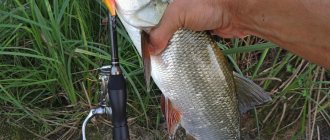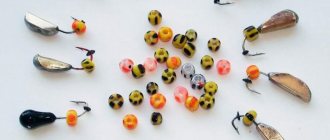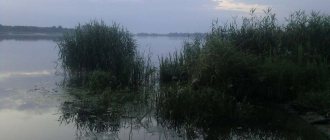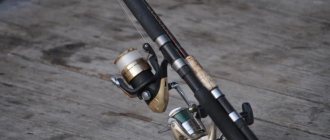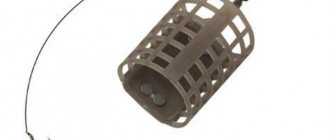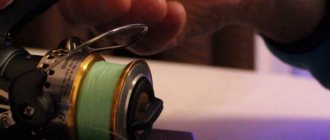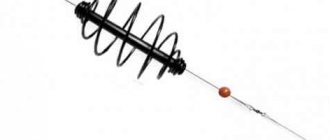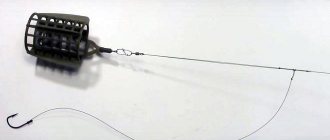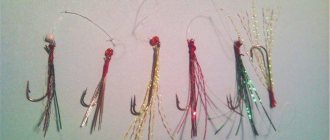The feeder is a classic English bottom tackle. A distinctive feature of this gear is the use of feeders. When fishing with a feeder, rods from 2.6 m to 4.1 m are used. The bite indicator is the tip of the rod or “quivertip”. A distinctive feature of the feeder is the method of constantly feeding the fish using a special bottom feeder. In this article we will analyze 11 feeder rigs, tell you how to assemble them correctly with your own hands, clarify which rig to choose for fishing in currents and in still water, and what is suitable for crucian carp, carp, bream and 9 other fish.
Table for selecting feeder equipment depending on the type of reservoir
To quickly understand which equipment should be used in a particular case, we have compiled a table for you.
| Equipment/pond | In still water | On the current |
| Paternoster | Yes | Yes |
| Asymmetrical loop | Yes | On the weak |
| Symmetrical loop | Yes | On the weak |
| Anti-twist | Yes | Yes |
| Inline | Yes | No |
| Method | Yes | No |
| Harvester | Yes | Yes |
| Helicopter | Yes | Yes |
Tips on feeder rigs will be useful for both beginners and experienced anglers.
Feeder for beginners TOP5 tips
- If you do not have experience working with a feeder, then it is better to choose places with the lowest percentage of wave and wind levels.
- At the beginning of fishing practice, try symmetrical and asymmetrical loops as equipment.
- Throw the bait only at the same point if there is nothing wrong with the bite there.
- Do not exceed the rod test ratings.
- Don't use too much flavoring in your bait.
Dear anglers, you can get more information, ask questions to professionals, and chat with beginners in feeder fishing in a special forum thread on our website.
No tail, no scales for everyone!
DIY installation of feeder equipment
Gardner's Paternoster
The most popular type of feeder equipment, invented by the English feeder fishing champion Steve Gardner. It is considered a classic of feeder fishing. The difference from the others is that the feeder is the final element of the main fishing line, and the leash is attached to the line, which runs from the middle of the distance to the feeder. However, it’s easier to understand by looking at the picture below.
pros
- Great sensitivity of the equipment, which allows you to notice a fish bite before the feeder starts moving.
- The feeder reaches the very bottom, falling through the thickness of green vegetation and other objects covering the path.
- It is very rare for fly fishing to catch the leader over the rig.
- Easy to assemble.
Minuses
- Slow self-cutting. You have to be ready all the time.
List of necessary elements for collecting any equipment listed by us:
- Fluorocarbon leader 40-90 centimeters long, 0.1-0.21 mm;
- Braided 0.1-0.18;
- Hook;
- Swivel;
- Stop beads;
- Feeder;
- Carbine.
Installation of equipment. A twisted fishing line is tied to the main line using a swivel assembly and stop beads (bullets) on its sides. One end of the twist goes to the feeder, the other to the leash with a hook. The twist and leash are connected with a surgical knot, then with a loop-to-loop connection, or a carabiner. The twist is tied to the feeder in two ways, picture below. Remember these connections, we will need them for installation and other equipment.
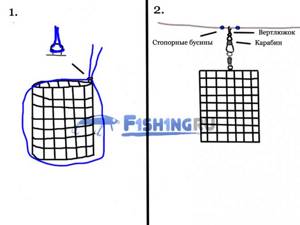
The length of the twist from the main line to the feeder is 25 cm. The length of the twist from the line to the leash is no more than 15 cm.
Asymmetrical loop
Asymmetrical, also known as an asymmetrical loop. Very popular recently, catchable feeder equipment. It is used both in weak currents and in standing water. It is a sliding equipment. However, any equipment with an unfixed feeder can be called sliding equipment. Some unofficially call it a “crucian rig,” which is probably due to its catchability of this particular fish.
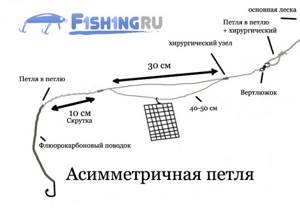
Installation instructions:
The rig is connected to the main line by a surgical knot with a loop-to-loop connection, a surgical knot, a swivel, or, less commonly, a crimp tube.
One line 30-60 cm long goes to the twist and then to the leash. The second line, on which the feeder will be, is taken 10 centimeters longer than the first, is also attached to the main line and also leads to the twist and leash. The feeder is fixed in the middle of the second line with stop beads. To attach two lines and twist, use a surgical knot.
The twist should be 10-15 cm long and end with a loop or carabiners for connection to the leash. The key points are fixing the feeder with stop beads and the fact that the second fishing line on which the feeder is attached should be 10 centimeters longer than the first. That is, if the length of the first line is 30 cm, then the length of the line with the feeder is 40 cm. The twist is 10 cm. The distance after the swivel with the main line to the beginning of the asymmetrical loop is 15 cm.
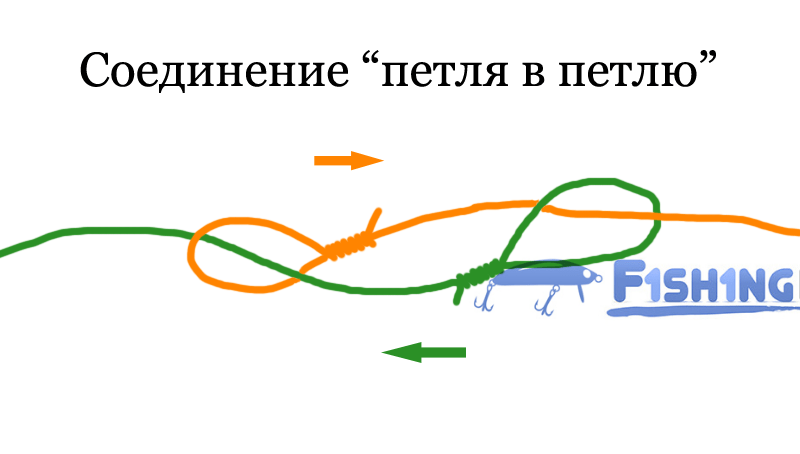
Symmetrical loop
Extremely sensitive feeder equipment, therefore not used in strong currents. The transience of the reservoir can be mistaken for a fish bite and a “blank shot” can be fired. Ideal for still water, it can easily compete with the Paternoster rig.
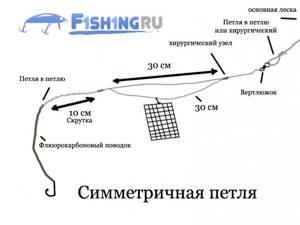
The “symmetrical loop” rig has the same structural principle as the asymmetrical rig, only two fishing lines are taken of the same length, 20-30 cm. A feeder with a swivel and stop beads is attached to one of them. It is better to knit all connections using a surgical knot and a loop-to-loop connection, this will reduce the chance of overlap. Symmetrical and asymmetrical rigs are used mainly for crucian carp.
Inline
Inline is secretly called carp equipment. It is self-clipping. It gets stuck less in the silt, and in case of a break, it gets rid of only the hook, but not the gear. It is used only in stagnant water, since only open and method feeders are used for inline feeding. There is an option with a retractable leash.
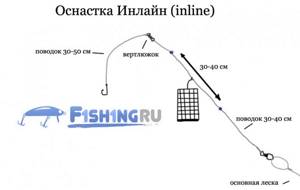
At the end of the main fishing line (which comes from the rod), a carabiner is attached using a surgical knot. From the carabiner there is a braided line 30-40 cm long. A stopper bead is attached to its end. The feeder is attached to the braiding itself without being fixed at all. After the beads there is a small piece of fishing line that connects to the swivel. On the other side of the swivel, a leash 50-80 cm long with a hook is attached. Other variations of the inline rig:
- The retractable leash can be fixed on the fishing line itself, leading to the feeder. But then you will have to use an insert with twisting.
- For greater strength, after placing the stop beads that limit the feeder, you can make an insert from braid.
- Using twisting with feedergum. From the main line there is a twist with a feedergam (elastic band) to the leash. This increases shock absorption and makes the bite more sensitive.
Video on using feedergam, youtube:
Flat method (Method)
Recently, the flat method rig has become increasingly popular among feeder fishing enthusiasts. The flat has a kind of feeder that resembles an arrowhead or an oval shape, in which the bait is stuck around so that it completely covers its base. Mostly bream, carp and tench are caught using this method. For this method, bait is made with a denser and stickier consistency so that it does not crumble when casting. They fish using the method in weak currents and in standing water.
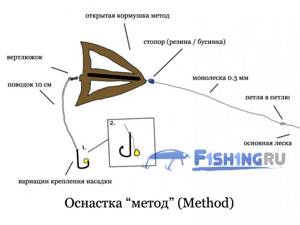
Installation instructions:
For fishing line here we will need strong carp monofilament 0.3 mm. The equipment is attached to the main fishing line using a loop-to-loop connection, followed by a fishing line 20-30 cm long. The fishing line ends with a “method” feeder and a rubber stopper. Then comes the connection to the swivel. A 10 cm long leash is attached to the other side of the swivel. The rig ends with a fluorocarbon leash. At the end there is a hook of size 10-16 with a nozzle made of canned corn kernels. The length of the entire equipment is about 40 cm.
The bait for the flat method rig should be different from the rest. It should be sticky and form a thick consistency. To do this, add molasses, a couple of drops of condensed milk, etc.
Equipment with anti-twist tube
An anti-twist (also known as an anti-twist) is a piece of equipment with a plastic tube to which is attached a swivel with a clasp that secures the feeder. The purpose of equipment with an anti-twist is that the fishing line will stop getting tangled. With such equipment it is simply impossible.
Equipment with an anti-twist can be used both in current and in still water. However, it performs best in strong currents. The durability and rigidity of the feeder fastenings do not allow it to lose the entire tackle under the current, which is an important aspect for beginning feeder lovers.
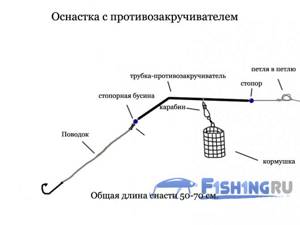
The equipment is attached to the main line using a loop-to-loop connection. Next comes a locking bead or rubber stopper, which will fix our tube in the same position. Then there is a tube on which the feeder is hung using a carabiner. You can also use surgical or other nodes, but this will not be as reliable. The tube also ends with a locking element. Next comes a small piece of fishing line that connects the rig to the leash and hook.
Important: use tough, thick line under the anti-twist to minimize breakage. The total length of the gear will be about 50 cm.
Variations of equipment with anti-twist:
- Immediately after connecting to the main line, you can place an additional leash with a hook. You can also select and combine different baits for two hooks.
- You can use a juice straw as an anti-twist, but it is worth remembering that with repeated use, such plastic tends to wear out and wear out.
Combine
The combine is practically the same equipment with an anti-twist, with the difference that the tube has a sharper bending angle and the feeder is attached not directly to the tube, but to the braid, and only then to the tube. This is done to make the equipment even more durable.

How to do it?
The equipment is attached to the main fishing line with a loop in a loop or a carabiner. Next is the cambric or stop beads. Then there is a tube on which a carabiner is attached, which hooks the fishing line to the feeder. Everything ends with a bead with a carabiner, which goes to a leash with a hook.
The distance of the fishing line from the feeder to the tube is no more than 5 cm. The length of the entire equipment should be up to 50 cm. Hooks are selected according to the size of the desired fish, but the classic feeder is hooks of sizes 10-16.
Sometimes it is advisable to use a special elastic band – feeder band – between the leash and the feeder equipment. It will allow you to dampen sudden jerks of fish and fish with a very thin leash (0.08-0.12 mm).
Helicopter and two knots
The helicopter feeder rig can be called universal for several reasons:
- Used when fishing for a wide variety of large fish: carp, bream, carp, silver bream, catfish, roach, etc.
- Performs well in the current;
- Self-clipping.
Monofilament line with parameters 0.22-0.36 mm is used as the main line. When fishing, the rod rises approximately 45 degrees relative to the water. This is done to ensure the correct placement of the feeder under water and uniform spraying of food.
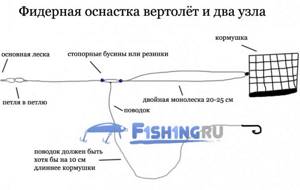
Take a monofilament line 40-50 cm long and fold it in half. The 2 ends of the fishing line are wound into a knot that will be attached to the main line of the feeder. We connect them with knots. A swivel with a fastener is attached to the other double end of the fishing line, to which the feeder in turn is attached. The leash will be located, oddly enough, also at the end of the main line coming from the rod.
It is important that when picking up the equipment, a leash with a hook hangs below, and not a feeder. At least 10 centimeters. The leash is attached to the same swivel at the end of the main line, or with any other knot of your choice. The leash is made of fluorocarbon in a transparent or faded color. The hook is taken in sizes 14-16.
The installation of this equipment can be very different, don’t be afraid to experiment.
Online video of catching bream and crucian carp on a feeder:
Online training video on feeder for beginners:
How to choose a feeder for a feeder
The purpose of the feeders is to deliver the prepared bait to the fishing point, and also to allow this bait to fully “open up”. If selected incorrectly for specific conditions, we will not get the desired effect, namely, we will not attract and keep fish in one place. There are several types of feeder feeders.
Feeders for starter feeding. These are large and open feeders with a large cell, from which the food is washed out very quickly. They are mainly used when it is impossible to throw a hand-made ball of food (for example, very far).

Supplementary feeders for standing water. This is a smaller copy of the previous view. The shape doesn't really matter. The main thing is that the size of the cell allows the bait to work unhindered, and gradually allows the food to be washed out of the cage.
Supplementary feeders for currents. Form plays an important role here. These should be feeders with a flat, weighted bottom to hold the equipment in one place and a small cell. In strong currents, closed feeders are used. The cell can close either partially on one side or completely.
Feeders for long casting. These feeders are made in the shape of a badminton rollercoaster. The flight range of such feeders is 25-30% greater than that of conventional feeders of the same weight. For living components, be it chopped worms, maggots or bloodworms, specially shaped cage feeders are used.
Choosing the right bait
In order for fishing with feeder tackle to be successful, it is very important to choose the right bait and bait for the fish. Thanks to the feeder design, the feeder with bait is located in close proximity to the hook with the nozzle, which of course significantly increases the angler’s chances. Sinking to the bottom, the feeder with bait forms a spot of odors attractive to fish. The design of the feeder prevents the bait from quickly disappearing; on the contrary, it holds it, thereby further warming up the fish’s appetite.
The bait consists of two main components: the first is the base, the second is the additive. All kinds of cereals are most often used as a base, which, having small particles, can be mixed with other components. Additives are larger ingredients (corn, grains, etc.). In addition, additives can provoke a certain aroma that attracts fish. Here are some recipes that have proven to be effective.
- The batch consists of halva 20%, a small amount of breadcrumbs 15%, boiled millet porridge 45%, gray bread 20%. After kneading, put it in the feeder and throw it in. You can put a maggot or a worm on the hook.
- Breadcrumbs 20%, millet porridge 50%, yogurt 30%. A maggot is placed on the hook.
- The batch consists of finely crushed peas (coffee grinder), cottage cheese, bread, we use garlic (ground) and dill oil as a flavoring. A worm is used as a bait.
Fishing technique
Fishing conditions in a particular area are the most important factor that influences the layout of gear, as well as fishing techniques and methods. Each area has its own characteristic features and therefore what works great, for example, on a lake, may turn out to be completely unsuitable for a river or reservoir. Here is a short list of rigs and the conditions to which they are suitable.
Mud bottom:
- If the bottom of the reservoir is covered with a large amount of silt. The best equipment option for such conditions would be the Paternoster.
- “Helicopter” also works well in such conditions (especially if long casts are required).
- The “Combine” equipment has proven its effectiveness many times in a variety of conditions. Therefore, mud is not a hindrance to her.
Long distance throw:
- In this case, a “Helicopter” with two nodes can help. The bait flies as far as necessary.
- Inline can also be a great help for long casts.
Content
- How to choose a rod for a feeder
- How to choose a reel for a feeder
- How to choose a fishing line for a feeder
- How to choose feeder equipment
- How to choose bait for a feeder
- How to choose a feeder for a feeder
- Professional opinion
- Feeder - training videos
- Feeder for beginners TOP5 tips
A feeder is a bottom tackle that includes two innovations. Firstly, this is the rod tip (quivertip), which serves as a bite alarm. Secondly, this is the use of other equipment and special feeders. And also a radically different approach to fishing, differing from the traditional one by more frequent casts. Feeder (from the English “feed” - to feed).

Selection of equipment according to the type of fish
Carp, carp
Carp is a powerful river fish, catching which brings great pleasure to fishermen.
When using feeder gear to catch carp, the angler must make sure that all its parts are made of high quality. After all, such a fish can break even the strongest tackle. Therefore, after installation it is worth checking everything again. As for feeder equipment options, the following are best suited for carp:
- Tackle method;
- Tackle, paternoster;
- Tackle asymmetrical loop.
Carp can grow to impressive sizes and therefore, when planning to catch them, you need to roughly understand which specimens are found in the reservoir. To avoid unnecessary breaks and unpleasant losses.
Feeder gear for carp fishing must have a strong design that can withstand the pressure of this giant. the method as equipment . The feeder installed in this gear can effectively distribute the aroma, thus attracting fish.
Roach
Roach is a lively small fish (although sometimes decent specimens are found) that every fisherman in our country knows.
There are a large number of avid fishermen who love to catch roach. Moreover, sometimes the catch of this fish can be really large. Feeder gear for roach fishing should not be too bulky. the paternoster is best suited . Because it allows the fisherman to react to the bite as quickly as possible.
crucian carp
This fish is well known to us since childhood. Most fishermen got their first big catch while hunting for crucian carp. This species is widespread and is therefore caught in a variety of conditions. Recently, crucian carp have also begun to be caught on a feeder, using the so-called Paternoster method. This gear allows you to do this quite effectively.
Crucian carp does not require particularly strong fishing line or other components. When hooked, the fish doesn’t behave particularly spiritedly, so getting it out of the water is not a difficult task.
Zander
Feeder gear was not originally designed for catching predators like pike perch. However, over time, many fishermen began to use components of feeder gear to catch pike perch specifically. Due to the fact that the feeder rod has good rigidity along its entire length and a very flexible and sensitive tip at the end. It has become an ideal option for bottom fishing for pike perch. Spinning rods with sliding weights are especially good at this. They allow the line to move freely, and the rod tip signals a bite. Paternoster and inline are best suited for catching walleye.
Som
Catfish is the largest river fish found on our continent. Even now, specimens weighing more than 100 kg are often caught. In ancient times, these monsters are said to have reached unimaginable sizes. Of course, every fisherman dreams of catching such a trophy.
One of the options for catching catfish was a feeder. Of course, when choosing gear for such fishing, you need to take the strongest fishing line and rod hooks. Paternoster is considered the best option for feeder equipment for catfish .
Gustera
This fish is found in many of our rivers. It is often caught in the same places as small bream. Moreover, it is caught both in rivers with strong currents and in ponds and lakes.
White breams use the Paternoster as equipment for feeder fishing. If you need to cast bait far away, use a Helicopter.
Bream
Bream is a very popular fish in our climate zone, having a wide habitat.
This species can reach quite impressive sizes, which makes such a catch desirable for many fishermen. Bream lives both in quiet waters of lakes and ponds, and in rivers with powerful currents. Bream are caught all over the world using a feeder, as this fish loves to take bait from the bottom. If you bait the place well and choose the bait well, you can catch a really big catch even with one tackle.
Used as feeder equipment.
- Tackle Helicopter with two knots.
- The loop is symmetrical.
- The loop is asymmetrical.
- Paternoster.
Ide
Like bream, this fish is very widespread in our latitudes. It can be seen in mountain lakes and rivers on the plain. Ide can reach quite decent sizes and therefore many fishermen catch it with great pleasure. Moreover, they catch it in a variety of ways, starting with ordinary fishing rods and ending with feeder gear. Moreover, the feeder has proven itself very well. The following equipment is used for feeder fishing:
- Helicopter for long casts.
- Paternoster.
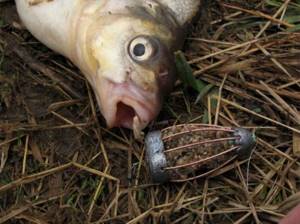
How to choose a reel for a feeder
Often, fishermen use one type of reel for a feeder, namely a spinless reel. However, regular spinning reels can also be suitable, but it is better if it is a reel designed for feeder fishing. Its main difference is a slightly enlarged main pair and more powerful mechanism parts.

By the way, some professional fishermen recommend that the feeder reel be equipped with a “baitrunner” system. This system is designed to instantly transfer the friction brake from operating mode to minimum. This will allow you to freely release the line and vice versa. This system is used to avoid troubles associated with biting large fish, such as falling from a stand and then being pulled into the water.
Gear selection
Choose a feeder rod based on 3 parameters: action, test, length.
We have a separate article on choosing specific models of feeder rods based on your preferences.
The test is the total amount of load that the rod can support.
There are five types of fishing rods, divided according to the test, these are:
- Ultralight (Ultralight);
- Light feeder (light);
- Medium (Average);
- Heavy (Heavy);
- Extra heavy rod (Very heavy).
We will choose only from the last three, since ultralight and light are no longer available due to their inability to support a feeder with food and other elements of feeder equipment.
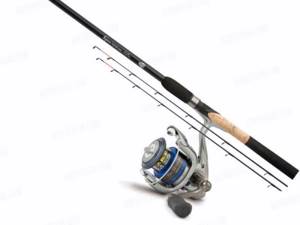
Shimano Vengeance Medium Feeder 3.66 and Shimano Technium FC 3000S
Medium class rod
Length from 3.3 to 3.6 meters. Maximum load 100g. This may well be enough if you use a small feeder and do not overload the equipment. Also, when calculating the weight, do not forget about the bait placed in the feeder, the average weight of which reaches 20-40 grams.
It is considered a universal feeder rod, as it allows you to fish both in still water and in small currents. Medium class rods are suitable for beginners and feeder fishing at shallow depths.
Heavy class rod
If we can say about the medium class that these are rods for catching small fish, then feeder rods of the “Heavy” class are an application for medium and larger fish. Length from 3.6 to 3.9 meters , with rare exceptions, when the length of twin models can reach 4.2 m. Design load from 100 to 120 grams. This allows you to cast the rig further and raise the rod higher, avoiding a snag and passing the rig over the edge.
Extra heavy rod
This class of feeder rods is designed to be a hunter for “trophies” of reservoirs. The length of the rod is from 4 to 5 meters, the maximum load is from 120 to 200, 250, and even 300 grams. The length allows you to make ultra-long casts, and therefore catch very large, massive specimens. Fishing with an extra-heavy rod implies feeder fishing on a large body of water and its complete helplessness when fishing on small ones.
Choosing a rod by action
The action of a rod is its sensitivity to load and bite. Conventional division of rods:
- Fast action - when only the rod tip bends;
- Medium – bends to the middle of the rod;
- Slow – the formation of a bend almost from the beginning of the rod.
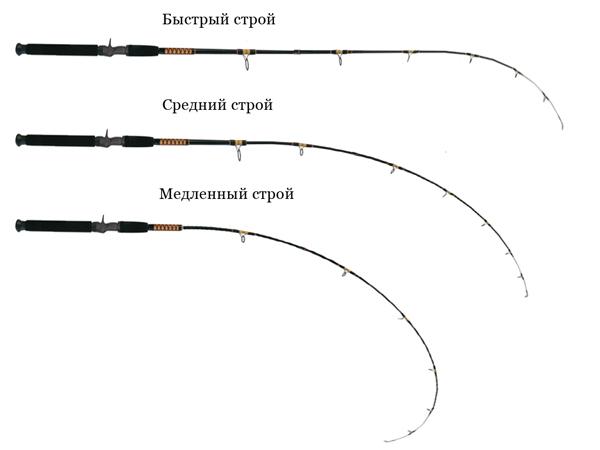
When fishing on a feeder with trophy specimens in the current, regardless of the class of your rod, choose only a fast action, this will allow you to hook the fish as efficiently and quickly as possible.
When fishing on a standing reservoir with a medium and near-medium fish, a medium action is also suitable. But never slow.
Fishing rod material
Everything is simple here. You need a reliable feeder rod and you are willing to pay for it - your choice is high-modulus graphite . In terms of strength, it can be compared to diamond, but it requires extremely careful handling and has a tendency to wear out quickly.
Cheap, heavy and “harsh” feeder rods are made from fiberglass. A rigid rod, not designed for delicate hands, resistant to wear and damage. An ideal choice for a beginner and a person for whom fishing is not a sport, but a real hunt.
The golden mean is the composite material. Not cheap, but quite resistant to wear. Weighs less than fiberglass, but more than graphite.

Passing rings
When purchasing, pay attention to the guide rings of the rod. They must be coated with titanium or aluminum oxide. Otherwise, you risk quickly erasing the guide rings, for example, when using braided fishing line frequently.
Brief summary. When feeder fishing in still water for medium-sized fish, use a heavy-duty, fast-action rod. When fishing in the current and for very long casts, use an “Extra Heavy” class rod with a fast action. When purchasing, look at the access rings; they should be coated with a coating that protects them from abrasion.
Rating of the best fishing rods according to f1sh1ng.ru:
- Salmo Diamond Feeder 120 . Length 3.6 m. Weight 100 g. Fast build. Test lb 120 gr. Average price 3800 rub.
- Mikado Mikazuki Twin Feeder 330/390. Length 3.9 m. Weight 400 g. Fast build. Test lb 140 gr. Average price 4700 rub.
- Shimano speedcast feeder 90. Length 3.96m. Weight 262. Fast action. Material: composite. Test gr. Average price 25,600 rub.
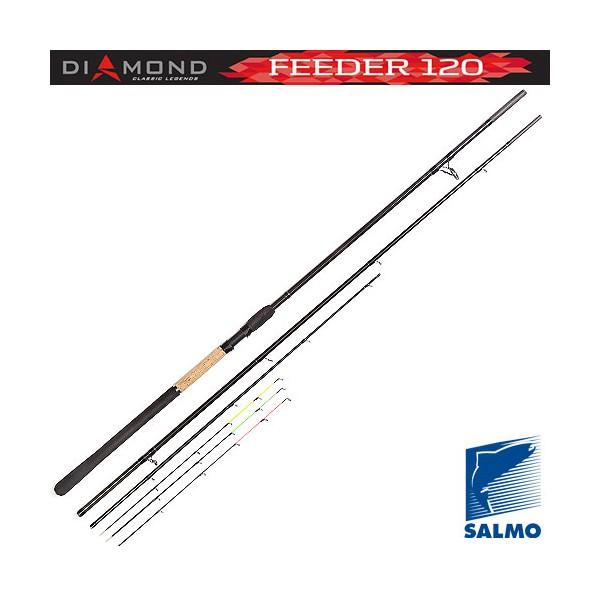
Salmo Diamond Feeder 120

Mikado Mikazuki Feeder 360
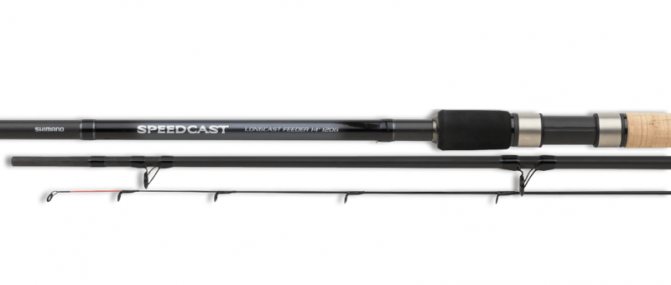
Shimano Speedcast Feeder 90
Coil selection
Coil type. Definitely inertialess. With a front clutch or a rear clutch - there is no exact advice, it is a matter of habit and personal convenience.
The gear ratio, also known as reduction, is responsible for the speed of winding the fishing line. Take 5:1, this is a classic feeder reel with adequate speed and a reduced risk of breakage.
The spool size for feeder fishing is acceptable from 3000 to 5500. For feeder fishing on a rod with a lb weight of up to 200 grams, take a reel with a spool size of up to 6000.
It’s good if your feeder reel has an anti-twist , which lays the line more compactly and significantly reduces the chance of the line getting tangled. It’s great if the reel is equipped with a baitrunner, which instantly weakens the drag and minimizes the chance of simply losing your gear. The baitrunner also makes a quiet sound when releasing the fishing line.
Bearings. Fishing experts have long agreed that it is not the quantity of bearings that is important, but their quality. Accordingly, you need to look not at the number, but at the name of the manufacturer. Chinese reel manufacturers will never guarantee the quality of bearings or reels in general. Famous reel manufacturers: Shimano, Abu Garcia, Daiwa.
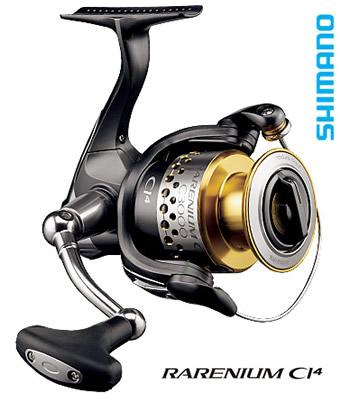
Shimano Rarenium cl4
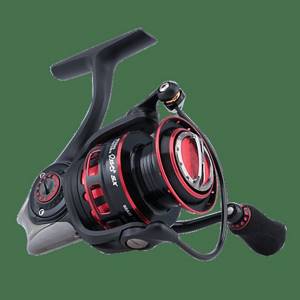
Abu Garcia
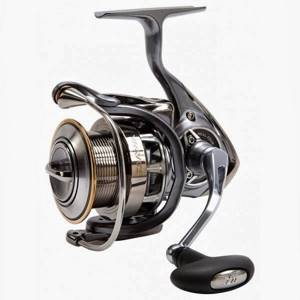
Shimano Rarenium Cl4
Result: Ideal feeder reel: inertia-free, size 3500-5500. With reduction 5:1. Availability of a baitrunner and Anti-Twist function.
Line selection
Main line
For close and medium feeder casts, use monofilament line:
- 0.12-0.18 mm for small and medium-sized individuals;
- 0.18-0.25 mm for larger individuals.
When fishing on a feeder with braid, diameters of 0.10-0.26 mm are used. In terms of color, there is no clear criterion. Braids of bright colors are clearly visible when reeling in, while dull or colorless braids are invisible in the water.
Leash line
Exclusively fluorocarbon. No monofilament or braided line will win the fight for the place of material for the feeder leader. Yes, it costs more, but if you buy one package for 100-120 meters, you will forget about questions regarding the leash for a long time. The feedergam option is also acceptable. Feeder Gum is a package of ready-made feeder gum that can be used to replace some places on the equipment, such as twisting. Feedergam makes the jerks of the fish more cushioned, that is, more readable for you.
Our rating of fluorocarbon lines for a leader when fishing on a feeder:
- Salmo fluorocarbon 0.14 mm – for medium fish;
- Sufix fluorocarbon 0.25 mm – for larger fish;
- Sunline siglon FC 0.35 mm – for catching trophy specimens.
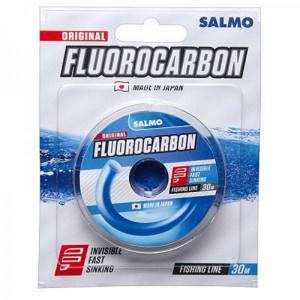
Salmo fluorocarbon 0.14 mm
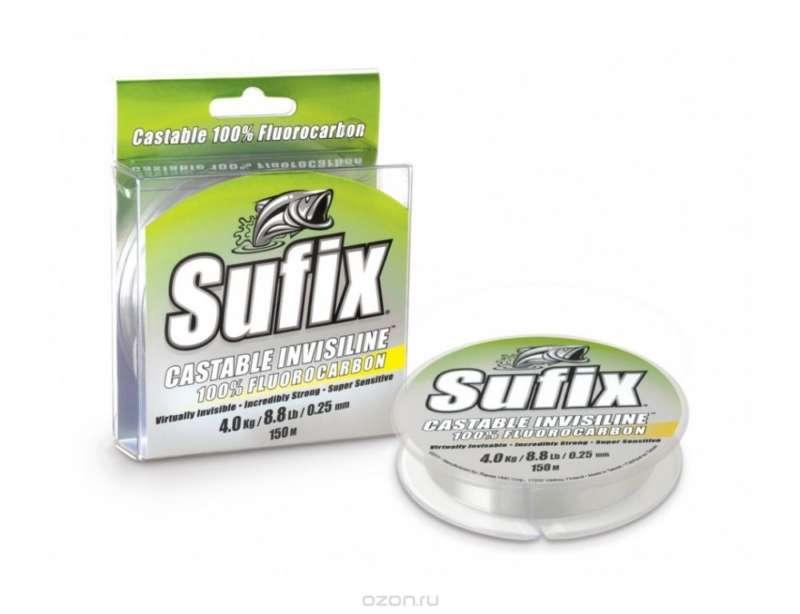
Sufix fluorocarbon 0.25 mm
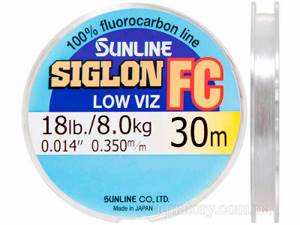
Sunline siglon FC 0.35 mm
Hook selection
Let’s leave empty discussion of purely subjective preferences to those who like to chat on forums, and name the best manufacturers of feeder hooks that really differ in the quality of sharpening, wear resistance, and price/quality ratio.
- Gamakatsu. The Japanese leader in our rating. Unfortunately, they have been disappearing from store shelves lately. The sharpest hooks that retain their sharpness for a long time, for little money.
- Owner. Japan again. In terms of quality, they wear out faster than the first ones, but the price is much lower.
- Mustad feeder. Hooks from Norwegian experts. On the market since 1877. You can buy any hooks labeled “feeder” or Superior Crystal; this series is also suitable for feeder fishing.
Hook sizes when fishing on a feeder vary from size 10 to 16 and even 18.
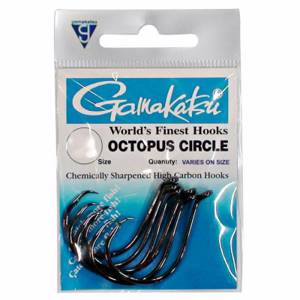
Gamakatsu
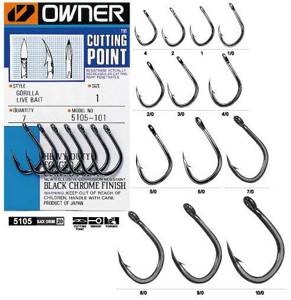
Owner
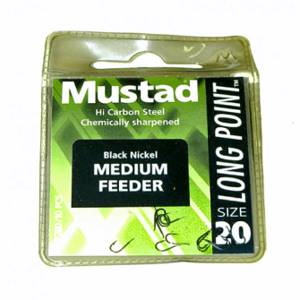
Mustad Medium Feeder
Choosing a feeder
When fishing with a feeder in still water (pond, lake), you can choose a minimally loaded feeder weighing 20-40 grams. You can use both semi-closed and closed feeders. In fact, feeders of any shape are suitable, but if you want to calculate the exact weight of the bait placed in the feeder, you will have to choose only a rectangular shape. The calculation is in the green block below.
When fishing with a feeder in the current, take closed or semi-closed type feeders. Never use sphere-shaped (rounded) or “spring” feeders. The former do not hold well in the current and begin to roll along the bottom, and the bait is very quickly washed out of the latter, which makes casting useless. The classic option is a “cage” feeder, which is fixed at the bottom and controls the supply of bait exactly to the required place.
The volume of bait is calculated using a simple school formula. First, we find out the volume of the feeder - V = A x B x C. Multiply the resulting amount by 1.1. Example: The height of the feeder is 2 cm, the width is 3, and the length is 5 cm = volume 30 cm cubic. Multiply by 1.1, we get 33. The approximate weight of the bait without a feeder is 33 grams.
How to choose a fishing line for a feeder
If you choose to fish with a feeder, then you can use either a simple mono line or a braided line. For short distances, the most suitable would be a monofilament, which has a certain stretchability and will slightly smooth out the jerks of the fish.
At short distances, the stretchability of monofilament fishing line has virtually no negative impact on hooking and the visibility of bites. The most popular diameter is 0.16-0.2 mm for small fish and 0.2-0.25 mm for fish larger than a kilogram.
At long casting distances, mono line will not be enough. For this you need braided line, namely the quality of braided fishing line, such as zero elongation. This is necessary to transmit the bite impulse to the tip. When using braid, be careful in the last phase of fishing, when the fish are already near the shore. The fight may end in an offensive ending.
Blitz tips
- Select bait depending on the type of reservoir. If there is no current, then use crumbly bait. For strong currents (large rivers) - dense, viscous.
- When fishing for large and trophy specimens, do not hesitate to use large sizes in baits and hook baits, for example, 2 grains of corn, or a whole bunch of maggots.
- Having found the edge of the tackle, do not leave the tackle halfway. Make several windings so that the feeder rises higher and the bait does not fall down. Or lower it to the very bottom.
- When you arrive at the place, feed immediately. While you are unloading and rigging, the fish will already be at your disposal.
- When fishing with maggot, chop it and add it to your bait. This will attract fish even more.
- When fishing in still water, use light feeders. Almost all stagnant bodies of water are muddy, in which you risk getting stuck.
- After 4-5 unsuccessful casts, stop trying and change location.
- If you make the equipment yourself, make sure that all elements are made of high-quality materials. A spoiled mood due to a failed fishing trip can keep you away from feeder fishing for a long time.
- To prevent the line from getting tangled, place the feeder above the leash. This arrangement of gear significantly reduces the risk of line tangling.
Tooling automation
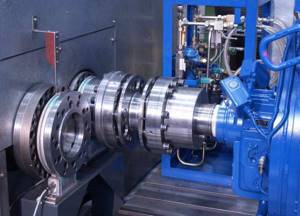
Previously, the functions of equipment were assigned mainly to technical means intended for manual handling. Then more efficient and productive mechanized analogues appeared. At the present stage of development of technological processes, equipment is increasingly endowed with automation functions. It is important to note that the driving source of automation is the main equipment, which controls its main components according to the same principle. At the same time, the technological equipment can operate both in a combined model and in semi-automatic mode. In such cases, a partially implemented principle of mechanized control is provided. For this purpose, hydraulic or pneumatic drives are used. One way or another, almost all modern enterprises are actively moving or have already switched to using the concept of automated control.
